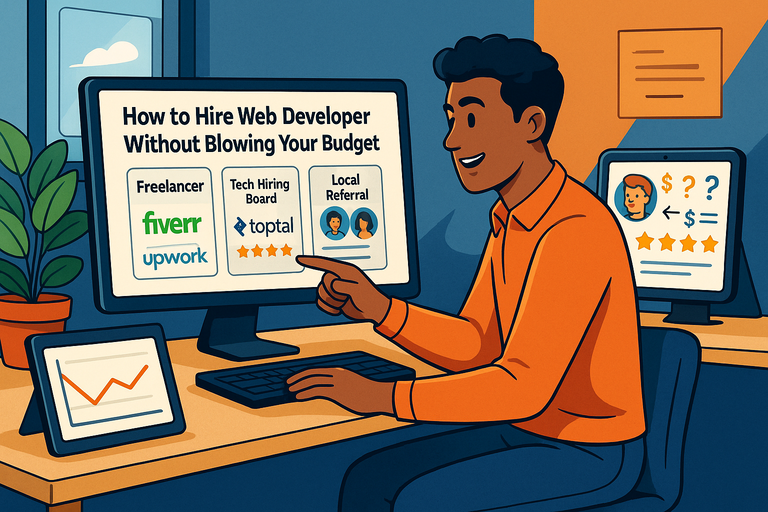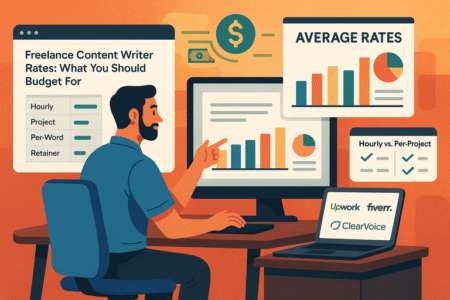Table of Contents
Hire web developer—three words that can make or break your business budget if you’re not careful. With so many options out there, from freelancers to agencies, how do you find the right person without draining your wallet?
In this guide, we’ll walk through practical steps to make smart hiring decisions while keeping costs in check.
Define Your Project Scope Before Searching
Before you even start looking to hire web developer candidates, you need to be absolutely clear about what you want built.
Without this, you’ll either overspend or end up paying for features you don’t really need. Think of it like renovating a house — if you don’t have a clear blueprint, costs spiral fast.
Outline Your Must-Have Features Clearly
Start by writing down the non-negotiables. If you’re building an eCommerce site, maybe you need:
- A product catalog with categories
- Secure checkout with Stripe or PayPal integration
- Mobile responsiveness so it works on all devices
I suggest opening a simple document or even a Trello board and creating a “must-have” column. Each feature should be written in plain language — no need for technical terms yet. The clearer you are, the easier it will be for a developer to give you an accurate estimate.
Here’s a quick example: Instead of saying “custom user authentication,” just write “users can create accounts and log in with email or Google.” A developer will translate that into technical requirements, but you avoid paying for features you didn’t intend.
Separate Essential Functions From “Nice-to-Haves”
This step is where budgets are saved. Many people blow their budget because they confuse what they want with what they need.
I recommend creating two lists:
- Essentials: The features your site can’t live without.
- Nice-to-haves: Things that would be cool but aren’t dealbreakers.
Example: A blog search filter might be handy, but launching without it won’t stop your site from functioning. Save it for later once you’ve validated your business idea.
Developers also appreciate when clients are realistic about priorities. It signals you’re serious about time and money management, which often makes them more flexible on pricing.
Estimate Time and Complexity to Avoid Surprises
Even if you’re not technical, you can still make a rough estimate of how much time things might take. For instance, setting up a simple contact form might take 2–3 hours, while integrating multiple payment gateways could take days.
A trick I often use: Ask two or three developers for rough timelines. If someone says a basic login page will take 40 hours, that’s a red flag. When you collect multiple opinions, you’ll start seeing patterns — and that helps you spot overpriced quotes.
I believe most budget overruns happen because people underestimate complexity. Spending one evening breaking your project into chunks will save you weeks of financial headaches later.
Choose Between Freelancer, Agency, or In-House Hire
Once you know what you need, the next question is: who should actually build it? The right choice here can either save you thousands or drain your entire budget.
Each option — freelancers, agencies, or in-house hires — has its pros and cons depending on the size and scope of your project.
Weigh the Cost Benefits of Freelancers for Small Projects
If your project is small or you just need a site built quickly, freelancers are usually the cheapest route. Platforms like Upwork or Fiverr are full of talented developers who charge anywhere from $15 to $60 per hour, depending on their experience and location.
The advantage is flexibility — you pay only for what you need. I once hired a freelancer to create a custom landing page for under $300, something an agency would’ve charged triple for.
The catch? Quality control. Some freelancers overpromise and underdeliver. That’s why I always recommend starting with a small test project, like fixing a bug or building one simple feature. If they handle it well, you can trust them with bigger parts of your site.
Consider Agencies for Scalability and Diverse Skills
Agencies are more expensive, but they bring a team to the table. If your site needs multiple skills — like front-end design, back-end coding, and SEO optimization — an agency can handle it all under one roof.
They’re also better for projects where deadlines are critical. An agency can assign multiple developers to your project at once, speeding up delivery. But you’ll pay for that convenience: agency rates often range from $75 to $200 per hour.
If you’re thinking long-term, an agency also gives you continuity. Even if one developer leaves, the agency has backups. For business-critical websites (like eCommerce stores that generate daily sales), that peace of mind can be worth the higher cost.
Understand When an In-House Developer Makes Sense
Hiring someone in-house only makes sense if you’ll need constant updates, maintenance, or new features rolling out every month. For example, if you’re running a SaaS product or a content-heavy site that evolves weekly, an in-house hire becomes more cost-effective over time.
While the upfront cost is higher (you’re paying a salary, benefits, maybe even office space), you gain direct control. Communication is smoother, revisions are faster, and there’s less back-and-forth compared to external hires.
I usually advise startups not to go this route until their website is already generating revenue. But if you’ve reached that stage, hiring a developer full-time can actually save money compared to paying agency rates month after month.
Use Trusted Platforms to Find Affordable Talent
When you’re ready to hire web developer candidates, the next challenge is knowing where to look. The right platform can connect you with quality talent while saving you time and money.
Each option has its strengths, and the best choice depends on the type of project you’re running.
Explore Freelancer Marketplaces Like Upwork or Fiverr
Freelance marketplaces are usually the first stop for small business owners. Sites like Upwork, Fiverr, and Freelancer.com have thousands of developers with varying skill levels and hourly rates.
Here’s how I personally use them:
- On Upwork, I post a job with a clear project scope and budget. Developers then send proposals, and I can check their reviews, past projects, and hourly rate before shortlisting.
- On Fiverr, I search directly for pre-packaged services (like “WordPress site setup for $200”). This is faster when I know exactly what I want.
One tip I recommend: Never just sort by lowest price. Instead, filter for developers with a 90%+ success rate and multiple completed projects. Paying $30/hour to someone reliable is far better than $10/hour to someone who disappears mid-project.
The beauty of these platforms is payment security. Funds are held in escrow until you’re satisfied, which gives you leverage if things don’t go as planned.
Check Specialized Tech Hiring Boards Such as Toptal
If you need higher-level expertise, sites like Toptal or Gun.io are worth exploring. They’re selective platforms that pre-vet developers, meaning you won’t have to sift through hundreds of unqualified candidates.
The downside is cost. Toptal developers often charge $60–$150 per hour, which might sound pricey if you’re on a tight budget. But if your project involves complex custom coding, this can actually save money by avoiding endless revisions or buggy code that needs fixing later.
I believe specialized boards are best when quality and speed matter more than cutting corners. Think of it like paying extra for a skilled surgeon instead of gambling on a general practitioner.
Compare Local Networks and Referrals to Online Options
Sometimes the best option isn’t online at all. I’ve had great success hiring developers through local business meetups, coworking spaces, and personal referrals.
The advantage here is trust. If someone you know recommends a developer, you start with a level of confidence that’s hard to get from an anonymous online profile. Plus, local developers understand your market context, which can be valuable for small businesses.
That said, local hires can be more expensive than global freelancers. A good compromise is to collect referrals but compare their rates against what you find online. This way you balance cost with reliability.
Evaluate Skills Without Overpaying
Not all developers are created equal, and price doesn’t always reflect quality. The trick is to test and evaluate skills in ways that protect your budget.
Request Small Paid Test Projects to Gauge Ability
Instead of committing to a big project right away, I suggest starting with a small paid test. This could be fixing a broken form, setting up a plugin, or building a single page.
Why paid? Because good developers don’t work for free, and offering a small payment shows respect for their time. It also gives you a realistic preview of how they communicate, how clean their code is, and whether they deliver on time.
I once hired a developer for a $50 bug fix, and that small test told me more about his skills than any résumé ever could. He later went on to build a full site for me with zero surprises.
Look Beyond Titles and Focus on Problem-Solving Skills
Fancy job titles can be misleading. Someone might call themselves a “Senior Full-Stack Engineer,” but what matters is whether they can actually solve your problems.
Here’s what I look for:
- How do they respond when I describe a challenge? Do they jump straight to jargon, or do they ask clarifying questions?
- Can they explain technical concepts in plain English? If they can, it usually means they understand their craft deeply.
A developer who thinks in terms of solutions instead of buzzwords is usually worth the investment, even if their hourly rate is higher.
Verify Technical Knowledge With Portfolios and Code Samples
Portfolios are gold. A solid developer should have live websites or apps you can click through, not just screenshots. I always spend 10–15 minutes testing those sites myself — checking speed, responsiveness, and whether features actually work.
If you’re technical, ask for code samples. If you’re not, at least ask them to walk you through a past project: what problem they solved, what tools they used, and how they handled setbacks.
I suggest staying away from anyone who gets defensive about showing real work. Transparency is a must when you’re trusting someone with your website.
Set a Realistic Budget and Stick to It
Even if you find the perfect developer, your budget will collapse if you don’t plan carefully. A clear budget keeps expectations aligned and protects you from scope creep.
Research Average Rates for Different Experience Levels
Rates vary wildly depending on geography and expertise. For example:
- Beginner freelancers: $15–$25/hour
- Mid-level developers: $30–$60/hour
- Senior specialists: $75–$150/hour
I believe it’s smart to aim for the middle. Beginners may be cheap but can cost you more in rework, while seniors may be overkill for a basic site. Matching skill level to project complexity is key.
If you’re unsure, ask multiple developers for quotes and compare. Over time, you’ll start seeing a “going rate” for your type of project.
Break Down Costs Into Milestones Instead of Lump Sums
Paying everything upfront is a recipe for disaster. Instead, structure payments around milestones. For example:
- 20% for initial setup
- 40% after major features are complete
- 40% upon final delivery and testing
This keeps the developer motivated and gives you checkpoints to review progress. Platforms like Upwork even let you set milestones directly in the dashboard, which automates this process.
I suggest keeping the final payment slightly larger — that way the developer has an incentive to finish strong.
Negotiate Upfront Terms to Avoid Hidden Charges
Budget surprises usually come from unclear terms. Always ask upfront:
- Does the price include revisions?
- Will you provide documentation for the code?
- Are hosting or third-party tool costs extra?
I like to put everything in writing before the project starts. It doesn’t need to be a 20-page contract — even a simple email agreement with bullet points can save you headaches later.
Negotiating early might feel uncomfortable, but it’s far better than arguing after the work is done. A professional developer will respect you more for setting boundaries.
Communicate Expectations to Prevent Scope Creep
When you hire web developer talent, miscommunication is the fastest way to blow your budget. Scope creep — those little “extra” requests that sneak in — can turn a $2,000 project into a $5,000 headache. Clear expectations upfront protect both you and your developer.
Define Deliverables and Deadlines in Writing
Always put things in writing. It doesn’t need to be a 20-page legal contract — even a Google Doc with bullet points will do. The key is clarity:
- What pages or features will be delivered?
- When will each be completed?
- What does “finished” actually mean?
For example, instead of just saying “login system,” write “user login with email or Google integration, mobile responsive, tested across Chrome and Safari.” The more specific you are, the less room there is for misunderstanding.
I’ve learned that vague instructions invite vague results. Being overly clear might feel nitpicky, but it saves time, money, and endless back-and-forth.
Use Project Management Tools to Track Progress
Relying on email alone is a recipe for lost details. Tools like Trello, Asana, or ClickUp give you a shared space where tasks, deadlines, and updates live.
For example, in Trello you can create a “To Do, In Progress, Done” board. Add each deliverable as a card with a due date. That way, you always see what’s moving and what’s stuck. Developers usually appreciate this too — it keeps communication structured instead of scattered.
Hold Regular Check-Ins Without Micromanaging
Weekly or bi-weekly check-ins keep everyone aligned. I suggest a short video call or even a written status update. Ask:
- What’s been completed this week?
- What’s next?
- Any roadblocks?
But avoid hovering. Micromanaging kills creativity and slows progress. Think of it like steering a ship: you set the course, but let the developer handle the sails.
Protect Yourself With Contracts and Clear Terms
Contracts might feel intimidating, but they’re your safety net. When you hire web developer help, contracts ensure you get what you pay for — and that your project doesn’t drift into legal gray areas.
Include Payment Schedules That Align With Deliverables
Break payments into milestones tied to specific results. For example:
- 20% upfront for project setup
- 40% after core features are delivered
- 40% after testing and final handoff
This structure keeps developers motivated and prevents you from paying in full before the work is done. If you’re using platforms like Upwork, the milestone system is already built in, making this step seamless.
Add Clauses for Confidentiality and Intellectual Property
If your project involves sensitive business data or unique ideas, you’ll want a confidentiality clause (often called an NDA — Non-Disclosure Agreement). This protects your information from being shared.
Equally important: Intellectual property rights. Make sure the agreement states that once payment is complete, the code, design, and content belong to you. Without this, you could end up in messy disputes later.
Outline What Happens If Timelines Are Not Met
Delays happen, but your agreement should address them. Will late delivery reduce the final payment? Will there be a grace period? Even a simple line like “delays beyond 14 days without communication result in reduced compensation” can prevent misunderstandings.
I believe contracts aren’t about mistrust — they’re about fairness. They give both you and your developer peace of mind, and that trust sets the tone for smoother collaboration.
Build Long-Term Value With the Right Hire
Finding a developer isn’t just about today’s project. When you hire web developer talent who’s reliable, you’re setting yourself up for long-term growth.
Maintain Good Relationships for Future Projects
I always treat good developers like gold. A simple “thank you,” prompt payments, and clear feedback go a long way. Developers often give priority to clients they enjoy working with, which means your future requests might get faster turnaround times.
Think of it like having a trusted mechanic — once you find someone good, you stick with them because they know your systems inside out.
Invest in Developers Who Learn and Grow With Your Needs
Technology changes fast. A developer who’s curious and adaptable is worth more than one who only knows today’s tools. During interviews, I like to ask, “What new skill are you learning right now?” Their answer often tells me if they’re the type to evolve with your business.
An adaptable developer might help you launch a basic WordPress site today but later guide you into more advanced tools like headless CMS platforms or app integrations. That continuity saves you from hiring fresh talent every time your business levels up.
Balance Cost Savings With Long-Term Reliability
Hiring the cheapest option may work in the short run, but websites need updates, bug fixes, and occasional upgrades. If your developer vanishes after launch, you’ll end up paying someone new to relearn everything from scratch.
I believe it’s smarter to pay a little more for someone reliable and trustworthy. In the long run, it saves time, frustration, and unexpected costs.
Pro Tip to Keep Your Budget Safe
Start small. Hire a developer for one feature or a limited project before handing them the keys to everything.
This approach lets you test their skills, communication, and reliability without risking your full budget. If it works out, scale up. If not, you’ve learned cheaply.






